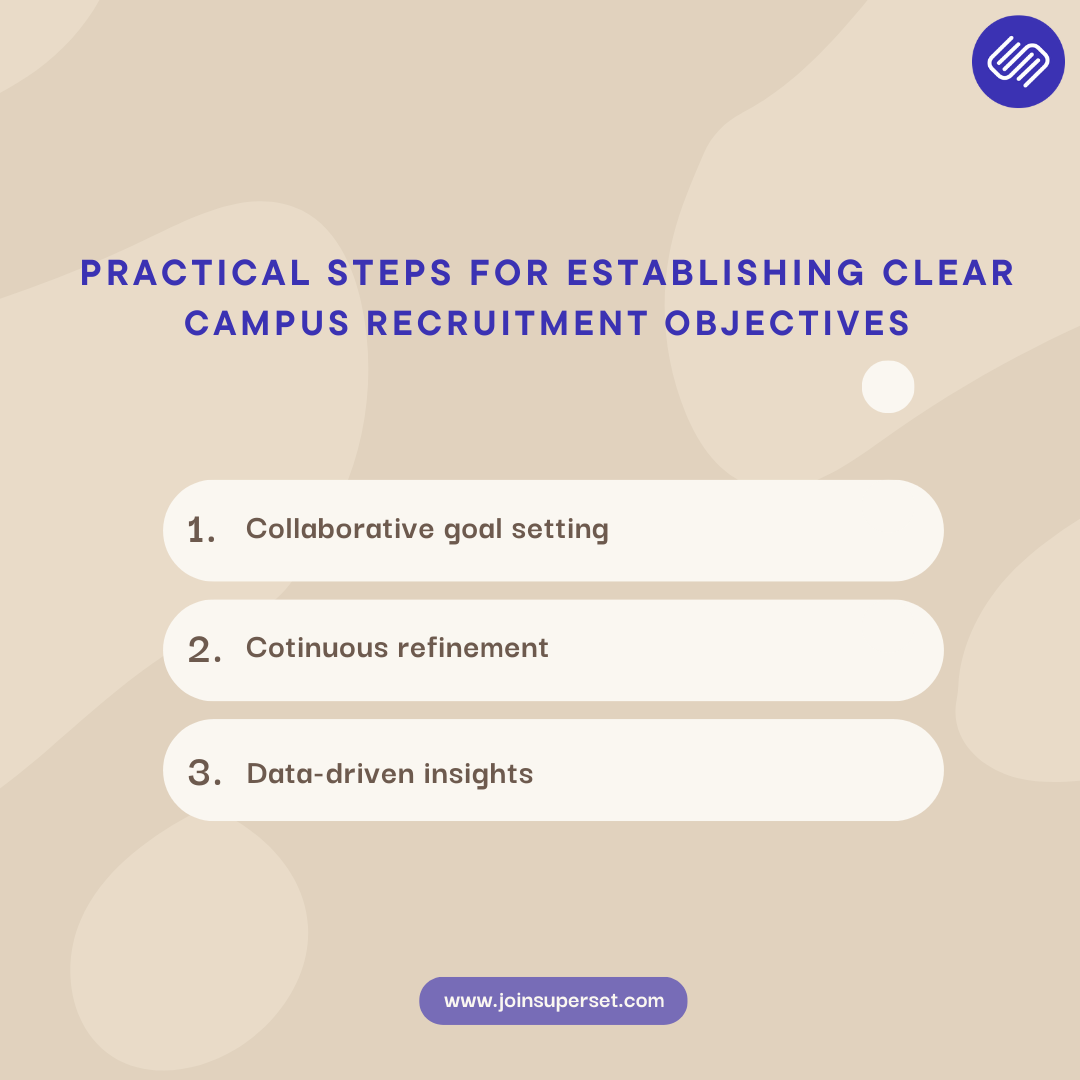Introduction
As we bid farewell to 2023, the ever-evolving landscape of campus recruitment prompts companies to reflect on the strategies that define their success. This comprehensive blog will delve into the intricacies of campus hiring, examining what worked, what didn’t, and how you can position your organization for excellence in 2024. From strategic planning to integrating cutting-edge technologies like campus recruitment software and automation, this blog aims to guide companies through a detailed exploration of the campus recruitment process.
1. Strategic Planning: A Foundation for Success
Defining Clear Objectives
Defining clear objectives is the cornerstone of an effective campus hiring strategy. When companies invest time in precisely outlining their hiring goals, the impact resonates across various facets of the recruitment process, contributing to a more streamlined and efficient operation. This section will delve into the significance of clear objectives and how they manifest in improved candidate selection and overall organizational alignment.
The Significance of Clear Objectives in Campus Recruitment
- Streamlined Recruitment Process:
Companies that define clear objectives experience a more streamlined recruitment process. The recruitment team can focus on sourcing candidates who closely align with these criteria by knowing exactly what skills, qualities, and attributes are essential for a role. This precision reduces time spent on irrelevant applications and accelerates the hiring timeline.
- Improved Candidate Selection:
Clear objectives act as a compass, guiding recruiters toward candidates who meet the technical requirements and align with the company’s culture and values. This holistic approach to candidate selection ensures a better fit for the organization, leading to higher employee satisfaction and retention.
- Organizational Alignment:
Well-defined objectives contribute to overall organizational alignment. When hiring goals align with the broader company strategy, new hires become integral contributors to the company’s mission and vision. This alignment enhances team cohesion and ensures the recruitment process is a strategic driver of organizational success.
Practical Steps for Establishing Clear Objectives

- Collaborative Goal-Setting:
Involve key stakeholders, including hiring managers, team leaders, and HR professionals, in the goal-setting process. This collaborative approach ensures that objectives are comprehensive and aligned with specific role requirements and broader organizational goals.
- Continuous Refinement:
Recognize that objectives may need adjustment based on changing business needs and industry trends. Regularly revisit and refine hiring goals to ensure they remain relevant and effective in attracting the right talent.
- Data-Driven Insights:
Leverage data analytics to gather insights into the success of past hires and recruitment strategies. Use this data to refine and optimize objectives, ensuring a continuous improvement cycle.
Aligning Recruitment Goals with Company Culture
In 2023, companies recognized the significance of cultural fit. Aligning recruitment goals with company culture is crucial for fostering a positive and sustainable work environment. In 2023, companies recognized the profound impact of cultural fit on employee satisfaction and retention rates. This alignment ensures that new hires not only possess the required skills but also resonate with the values and ethos of the organization.
2. Engaging Employer Branding: Building a Magnet for Talent
Showcasing Values and Work Culture
Effectively showcasing your company’s values and work culture is pivotal for attracting top talent. In 2023, companies realized that a robust employer brand, rooted in authentic values, significantly impacts their ability to draw in qualified candidates. This section explores actionable strategies to highlight your organization’s values and work culture, creating an employer brand that resonates with the aspirations of the workforce you aim to build.
- Compelling Narrative: Develop a genuine narrative that reflects your company’s values and culture.
- Employee Testimonials: Feature authentic testimonials and success stories from current employees.
- Visual Storytelling: Use multimedia channels to communicate your company’s unique culture visually.
- CSR Initiatives: Showcase your commitment to corporate social responsibility and community engagement.
- Interactive Recruitment Events: Organize events for candidates to experience your values and culture firsthand.
- Consistent Branding: Ensure a consistent employer brand across all platforms for a unified message.
- Employee Resource Groups: Leverage ERGs to highlight diversity, inclusion, and various perspectives.
- Feedback and Iteration: Encourage feedback and continuously refine your strategies based on insights.
Differentiating Your Company
We’ll delve into strategies for differentiating your company from competitors, making your organization an attractive prospect for potential candidates.
- Unique Selling Proposition (USP):
Identify and articulate your company’s USP – what makes it distinct and superior to others in the industry. Highlighting specific strengths, whether innovative practices, a supportive work culture, or cutting-edge technologies, creates a compelling narrative for candidates.
- Targeted Messaging:
Tailor your messaging to resonate with your target audience’s specific interests and aspirations. Understanding the demographics and preferences of potential candidates allows you to communicate in a way that appeals directly to their motivations, increasing the likelihood of engagement.
- Employee-Centric Approach:
Showcase your commitment to employee well-being and growth. Emphasize professional development opportunities, mentorship programs, and a positive work environment. A company that invests in its employees is an employer of choice.
- Innovative Recruitment Practices:
Differentiate your recruitment process by incorporating innovative practices whether it’s gamified assessments, interactive interviews, or unconventional hiring events; a unique approach signals that your company values creativity and forward-thinking.
- Recognition and Awards:
Highlight any industry awards, certifications, or recognitions your company has received. External validations add credibility and serve as a testament to your organization’s excellence, making it an attractive proposition for potential candidates.
- Company Culture Showcases:
Create opportunities for potential candidates to glimpse your company culture. This could include virtual office tours, employee spotlights on social media, or testimonials that offer a firsthand look into the day-to-day experiences of your team.
- Emphasis on Diversity and Inclusion:
Differentiate your company by placing a strong emphasis on diversity and inclusion. Showcase initiatives, policies, and achievements demonstrating your commitment to fostering a diverse and inclusive workplace.
- Transparency and Communication:
Foster transparent communication throughout the recruitment process. Keep candidates informed about the stages, expectations, and company culture. Open and honest communication builds trust and sets your organization apart.
3. Streamlined Campus Hiring Process: The Art of Efficiency
Initial Candidate Engagement
The campus hiring process involves multiple touchpoints. Discover effective strategies for engaging candidates from the first interaction, ensuring a positive and memorable experience.
- Personalized Communication:
Tailor your initial communications to the candidate, showcasing genuine interest in their skills and aspirations. Personalization sets a positive tone and demonstrates a commitment to understanding individual needs.
- Clear Communication Channels:
Establish clear and accessible communication channels for candidates to ask questions or seek clarification. This accessibility fosters an open dialogue and ensures candidates feel supported.
- Interactive Introduction Materials:
Replace traditional introductory materials with interactive content. Video messages from key team members, virtual office tours, or engaging onboarding materials give candidates a dynamic and immersive introduction to your company culture.
- Timely and Constructive Feedback:
Provide timely and constructive feedback, even at the initial stages. This keeps candidates informed and reflects transparency, showcasing your organization as one that values clear communication.
- Virtual Engagement Events:
Organize virtual engagement events to allow candidates to interact with current employees and gain insights into your company culture. These events create a sense of connection and excitement early in the hiring process.
Leveraging Technology for Efficiency
Technology plays a pivotal role in optimizing and streamlining processes in the contemporary campus recruitment landscape. Integrating campus recruitment software is a transformative tool, enabling companies to enhance efficiency and seamlessly manage the entire recruitment lifecycle within a centralized platform.
Role of Technology in Streamlining the Campus Hiring Process

- Efficient Outreach:
Campus recruitment software facilitates efficient outreach to potential candidates. Through targeted communication and engagement tools, organizations can effectively connect with a broader pool of students, ensuring a wider reach for their recruitment efforts.
- Centralized Data Management:
The software serves as a centralized hub for managing candidate data. From collecting resumes to storing interview feedback, all information is organized in one accessible location. This streamlined approach minimizes the risk of data discrepancies and enhances overall data management efficiency.
- Virtual Interview Platforms:
By integrating virtual interview functionalities, campus recruitment software eliminates geographical constraints. Companies can conduct interviews seamlessly, connecting with candidates from diverse locations. This saves time and broadens the talent pool by accommodating remote candidates.
- Resume Shortlisting Automation:
Automation features within the software streamline the initial resume shortlisting process. Algorithms and filters can be applied to efficiently identify candidates whose qualifications align with the job requirements, allowing recruiters to focus on more strategic aspects of candidate evaluation.
- Integrated Dashboard for Recruitment Tasks:
Campus recruitment software provides a unified dashboard for managing various recruitment tasks. Recruiters can track candidate progress, schedule interviews, and monitor feedback all in one place. This integrated approach enhances collaboration among team members and ensures a cohesive recruitment process.
- Offer Management:
The software extends its capabilities to offer management, allowing organizations to roll out offers to selected candidates efficiently. This feature simplifies the administrative tasks associated with the final stages of recruitment, promoting a smoother and more organized hiring process.
Campus Recruitment Outlook for 2024: Navigating Future Trends
The campus recruitment landscape is evolving, and virtual career fairs are emerging as a key trend in 2024. These online events transcend geographical limitations, providing companies with a unique opportunity to expand their reach and engage with a diverse pool of candidates.
Virtual Career Fairs
The rise of virtual career fairs and their role in expanding reach and engagement.
- Geographical Accessibility:
Virtual career fairs eliminate the constraints of physical location, allowing companies to connect with talent from various universities and regions. This expanded geographical accessibility increases the diversity of candidates accessible to recruiters.
- Enhanced Engagement Tools:
Virtual platforms offer interactive features like live chat, video presentations, and virtual booths. These engagement tools go beyond traditional career fairs, providing a dynamic and immersive experience for both recruiters and candidates.
- Cost-Effective and Sustainable:
Hosting virtual career fairs is a cost-effective alternative to traditional in-person events. Companies can save on travel and accommodation expenses while contributing to sustainable practices by reducing their carbon footprint.
AI in Candidate Assessment: Shaping the Future of Recruitment
Artificial Intelligence (AI) is revolutionizing candidate assessment processes, offering a glimpse into the future of recruitment. In 2024, companies are integrating AI-driven tools to enhance the efficiency and accuracy of candidate evaluation.
- Data-Driven Decision-Making:
AI in candidate assessment relies on data analytics to provide objective insights into candidates’ skills, competencies, and cultural fit. This data-driven approach facilitates more informed and strategic decision-making throughout the recruitment process.
- Efficiency and Speed:
AI-powered tools automate repetitive tasks, significantly reducing the time spent on manual processes. From resume screening to video interview analysis, AI accelerates the recruitment timeline, allowing companies to secure top talent more efficiently.
- Predictive Analytics:
Predictive analytics algorithms assess historical data to predict a candidate’s future performance and potential within the organization. This forward-looking approach aids in identifying candidates who align with long-term company goals.
Adapting to Remote Work Dynamics: Navigating Challenges and Strategies
The remote work paradigm introduced challenges in the hiring process in 2023. As we move into 2024, understanding the dynamics of remote work and implementing effective strategies will be crucial for successful campus recruitment.
- Remote Hiring Challenges:
Insights into the challenges faced by companies during remote hiring in 2023, such as communication barriers, candidate onboarding, and maintaining a cohesive company culture in a virtual environment.
- Strategies for Success:
Explore successful strategies implemented by companies to overcome remote hiring challenges. These strategies offer a roadmap for effective remote hiring, from leveraging virtual onboarding tools to fostering a sense of community through digital platforms.
Conclusion
In conclusion, the campus recruitment landscape 2023 showcased the importance of strategic planning, technological integration, and a people-centric approach. As we enter 2024, companies must leverage these insights to stay ahead of the curve. By adopting cutting-edge technologies like campus recruitment software and automation, aligning recruitment goals with company culture, and embracing diversity, organizations can create a talent acquisition strategy that attracts top talent and fosters long-term success in a competitive job market.








